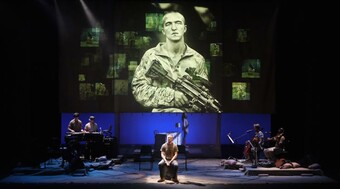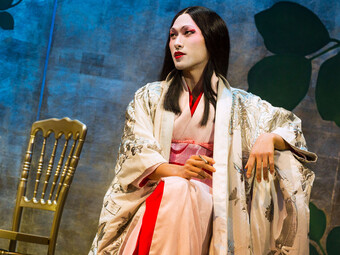Talking About The Sonic Life of a Giant Tortoise by Toshiki Okada at JACK
This article is about a play I saw at JACK, a performance space in Brooklyn. It’s called Sonic Life of a Giant Tortoise by Toshiki Okada, a Japanese playwright. It was translated by Aya Ogawa, a Brooklyn based writer, director and performer, and directed by Dan Rothenberg of Pig Iron. Sonic falls squarely into the “downtown” theater world—which can mean many things. I think colloquially it means not linear, probably experimenting with form in some way, and potentially not focused on a narrative. These qualities are true of many downtown plays, and not true of others, so please don’t pick on this generalization…it’s just that. A generalization. But I say this to give you a bit of context. The piece begins when we, the audience members, are introduced to a group of everyman city dwellers (much like the people watching the show), who speak to us directly about their lives. Everything is seemingly fine—their careers, relationships, family. But as the play goes on, they begin to narrate their deeper desires. And what emerges is a hilarious (and painfully familiar) portrait of life as a thirty-something urbanite. “First world problems” are exposed and examined in a deliciously self-aware way.
Before I talk about my thoughts on the play, I want to tell you upfront that I really, really liked it. It was one of the best plays I’ve seen in a while. As I was sitting down to write this piece—where I talk about the show, and where I share some of director Dan Rothenberg’s thoughts on it, and the process of making it—I remembered reading Lauren Gunderson’s brilliant and generous American Critics Association (ACA) keynote speech from this past spring. You can read it here or watch it here. Basically, the ACA asked Lauren, a playwright, to come and talk to a bunch of theater critics about theatrical criticism. We can all agree that like the field of theater in general, the field of theatrical criticism could use a serious reimagining.
So Lauren gets up there in front of all these critics and delivers an awesome speech. Smart and funny and seriously on point. In it, she asks (I’m paraphrasing) what would happen if all critics and people who wrote about the theater told you about their own personal tastes before you read the article? What if you knew that a major critic’s favorite play was Life is a Dream? Maybe you would think about their review of an avant-garde movement piece and context it differently, rather than dismissing the piece as “bad” because of unfavorable reviews. Tons of major critics and publications (and artists! We’re guilty too!) don’t acknowledge that a show one person might walk out of in disgust, another person might be telling people about for years to come.
What would happen if all critics and people who wrote about the theater told you about their own personal tastes before you read the article?
So, as someone charged with writing about this play, I’ve decided to take Lauren’s challenge in hopes that others who write and talk about theater can do the same.
Three of my top moments in the theater last year (there were more, but these leapt out as I was thinking) were:
- The moment in Tina Satter’s House of Dance at Abrons Art Center when Jess Barbagallo comes in to get ready for class and we watch for several minutes as Jess and Jess’ classmates get ready in silence. This is because I think watching choreographed banality is hilarious. I love watching people do truly real, slow, everyday things. And it was a geniusly executed moment.
- All of act one of Mr. Burns at Playwrights Horizons. Also the line in act two where Matt Maher says, (after being saddled with additional stage business) “there’s a lot going on back here.” Matt’s a brilliant actor and the absurdity of the moment was expertly rendered.
- Beth Hoyt’s performance of both the male and female lead in Leah Nanako Winkler’s Death for Sydney Black at TerraNova Collective. My favorite moment was when, as the male lead, she described her blow job as making her “feel like a little king.” I laughed so hard I cried. I’m doing a bad job at conveying it, but I promise it was really funny.
So that’s me. I like things that are funny. I like tons of traditional linear plays (In the Wake by Lisa Kron is amazing, and I adore it), musicals (yes, Ragtime, you are okay by me), and I am totally open to experimental pieces if they are really trying to engage me as the audience member and take me on a journey, rather than just do weird things I don’t understand. I like things that are structured differently than normal plays. I like things that play with form and live outside what we’ve determined is theatrical realism, but which live inside actual realism—we’re here, in this space, right now. The Sonic Life of a Giant Tortoise does all those things. It also did/had a bunch of other things I liked. Here’s a list:
- It had an amazing (and diverse) cast. Twice, the audience (myself included) laughed simply when a new actor walked in. They hadn’t even spoken a word. I want to particularly highlight Susannah Flood, who was just amazing. Though truly, the whole cast was perfect.
- It was theatrical without being fake. It was exciting and funny and it transported me, but I also felt like everything was honest and real and not “theater-y” in a way that feels self-important and turns me off. This did not turn me off.
- I wasn’t bored ever.
- It was really unlike anything I’d ever seen before (so in that sense “experimental”—particularly in the performance style), but it also wasn’t overly pretentious and I never felt left out. I could have brought my parents and they would have liked it. But also, I liked it too. This is a rare combination.
- There was hilarious dancing.
- The writing was really good—the play itself and the translation. It’s the kind of writing I love because you hear something and you think, “I’ve never thought of it like that,” but at the same time, you realize you have always been thinking that…you’ve just never articulated it.
- It was funny. But not cheesy funny. Actually funny.
- It was an hour long. (That’s not to say all long plays aren’t good but let’s be real, who isn’t excited when something is only an hour?)
- It was smart and specific and everything was on purpose.
- I loved the costumes. They are all street clothes that are really carefully curated, and once I got to “know” the cast I would start to see all these little details that were really funny in their outfits.

So after I saw it, The Play Company’s press rep (who invited me to see the show in the first place) put me in touch with the director, Dan Rothenberg so I could send him some questions to add to this article. This is what I asked him and what he said:
Morgan: The performance quality the actors inhabited was really specific—it was clearly trying to strip away traditional "acting" and "performance," and yet, at the same time, fully aware of the fact we were watching them in a show, fully engaged in comedic timing and pace, etc. How did you cultivate that quality? Particularly in rehearsals with no audience? What were the traps? I'm sure it was extremely difficult to walk the line...
Dan: I’m quite pleased that people are noticing this very particular style, and what fine work the actors are doing with it. I agree, it’s not easy! And there are traps. I have worked with Pig Iron over the past two decades—we always wanted to be both a producing ensemble and a laboratory. At its best, the performance research leads to exciting states of performance; we work hard on the idea that everyone needs to be in the same play, the same world, that this isn’t an easy task. And for many years we worked on “contact with the audience.” This comes from clown (theater). But we also worked with hybrids of cabaret, and site specific work, and work in which we “cast” the audience… all of this language has been a good running start to dive into the world of Toshiki Okada’s long monologues of description.
There are several sections of Okada’s 2005 play Enjoy in which two people tell a story to the audience in tandem. I think this is something we experience often in real life but it’s pretty rare on stage, and so it’s a kind of rare pleasure to see it. It feels “untheatrical” even though there’s plenty of performance-attention that needs to be brought to bear.
Morgan: The cast is obviously phenomenal. I noticed some of them have worked with you before, maybe others haven't. Did they audition? How did you know this was the group? Especially knowing that even really skilled actors have a lot of trouble nailing this particular brand of performance style, which make them discard a lot of normal actor tricks.
Dan: I knew two from years ago as students, two were totally new to me, and one I’d seen perform a couple of times. But really I’d never worked with anyone from this cast in a professional production. They auditioned, which involved working with the Okada text and improvising, and then we did group callbacks, which are always very important to me. I need to see how people communicate on stage, how they take up space together and make micro-adjustments to their work based on other people’s energies.
Recently they cracked up when I said, well, I guess I’m continuing my tradition of casting very funny, imaginative actors and asking them to do minimalism.
Obviously this is a multi-racial cast of New Yorkers portraying Japanese people. I figured that Toshiki plays so many tricks with who plays who (men playing women, characters sliding between different actors, people dreaming each other and living as examples)—that it was important to communicate to the New York audience: “this is you” and underline that this is theater, in the casting, in contrast to the very casual vibe of the performances.
Morgan: By the way, I thought the translation was amazing—it felt familiar and foreign all at once, in a totally cool way that kept me in the loop and on my toes all at the same time!
Dan: Aya Ogawa needs to win an award for these translations. They are major accomplishments; when you talk to her about some of the challenges she faces, translating this text—for instance, in many Japanese sentences the subject is implied by context, there is no “he” or “she”—so think about what that means for a play in which character floats from actor to actor!
Morgan: If you had to choose a line of text in the show that sums up the show, what would it be? What about a line that sums up the process of making the show?
Dan: I can’t do it. The show accumulates, rather than lands. The subject matter, in some ways it is about the struggle to stay awake, and the rueful laughing at all the ‘sayings’ we repeat to ourselves, things we know are true but just can’t feel are true.
I’ve watched a lot of Western journalists ask Toshiki about his Japanese influences, and sometimes about Buddhism, but he always replies that his biggest influences are Beckett and Brecht. Working on this play I thought a lot about the end of Waiting for Godot, when Vladimir says, “At me too someone is looking, of me too someone is saying, he is sleeping, he knows nothing, let him sleep on.”









Comments
The article is just the start of the conversation—we want to know what you think about this subject, too! HowlRound is a space for knowledge-sharing, and we welcome spirited, thoughtful, and on-topic dialogue. Find our full comments policy here
Why "re-imagine", why not "recommit"? Classical criticism seeks to contextualize the content and form within the artist's intention. The post-modern move to innovate towards subjectivity, seems to do a disservice to the intellectual potential, inherent to the critic. The multiple calls to "re-imagine" within theater makes me worried that the attention to craft is disappearing, within self-justified reactions, that are momentary, and not sustainable.
Can you be subjective an intellectual? Why are they mutually exclusive?
Because operating from the type of post-modernism subjectivity described here negates critical context. It clarifies nothing and does a disservice to thought by making it too personal. The post-modern premise suggests that no objective knowledge can be known. That then makes cultural criticism moot. It eliminates any opportunity for aesthetics or epistemology by depriving the reader of cultural or historical context. And, it is behind the curve in terms of where theories of mind are heading. The work in neuroscience are establishing that human experience is contextual and the appeal to post-modernism as any sort of framework for knowledge is limited.